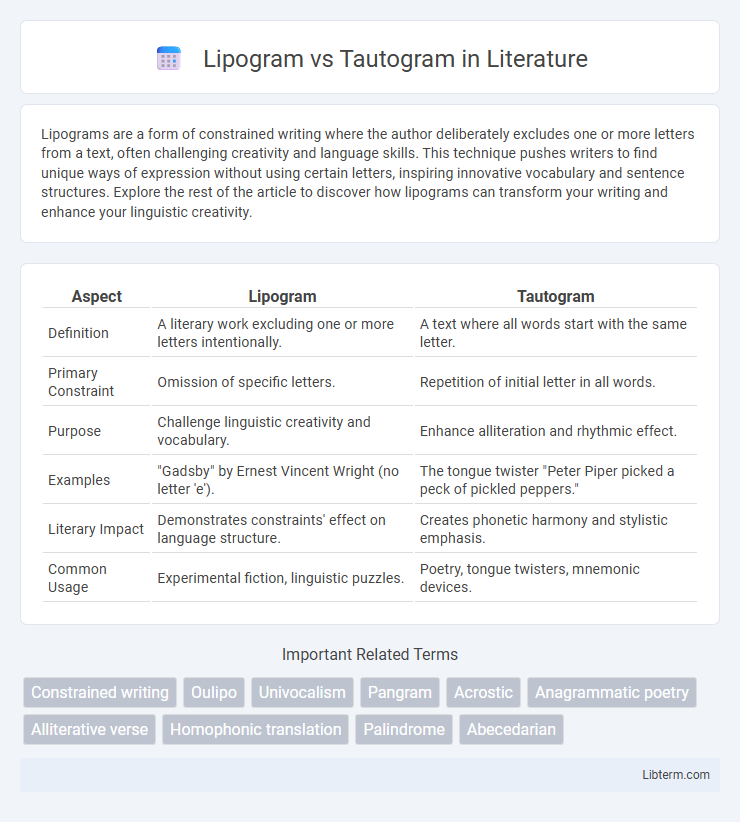Lipograms are a form of constrained writing where the author deliberately excludes one or more letters from a text, often challenging creativity and language skills. This technique pushes writers to find unique ways of expression without using certain letters, inspiring innovative vocabulary and sentence structures. Explore the rest of the article to discover how lipograms can transform your writing and enhance your linguistic creativity.
Table of Comparison
| Aspect | Lipogram | Tautogram |
|---|---|---|
| Definition | A literary work excluding one or more letters intentionally. | A text where all words start with the same letter. |
| Primary Constraint | Omission of specific letters. | Repetition of initial letter in all words. |
| Purpose | Challenge linguistic creativity and vocabulary. | Enhance alliteration and rhythmic effect. |
| Examples | "Gadsby" by Ernest Vincent Wright (no letter 'e'). | The tongue twister "Peter Piper picked a peck of pickled peppers." |
| Literary Impact | Demonstrates constraints' effect on language structure. | Creates phonetic harmony and stylistic emphasis. |
| Common Usage | Experimental fiction, linguistic puzzles. | Poetry, tongue twisters, mnemonic devices. |
Understanding Lipograms: Definition and Examples
Lipograms are a type of constrained writing where the author intentionally omits a particular letter or group of letters throughout the entire text, creating a unique linguistic challenge. Famous examples include Ernest Vincent Wright's novel "Gadsby," which excludes the letter "e" entirely, and Georges Perec's French novel "La Disparition," also without the letter "e." This form of writing enhances creativity by forcing authors to rethink vocabulary and sentence structures while maintaining readability and coherence.
What is a Tautogram? Key Features and Illustrations
A tautogram is a type of constrained writing where every word in a sentence or phrase begins with the same letter, showcasing alliteration on a larger scale. Key features include uniform initial letters, rhythmic repetition, and enhanced mnemonic impact, often used in poetry and tongue twisters. For example, "Silly snakes slither silently southward" illustrates how tautograms create memorable, stylistically unified expressions.
Historical Origins of Lipograms and Tautograms
Lipograms originate from ancient Greek literature, with the earliest known examples found in the works of the poet Lasus of Hermione around the 5th century BCE, who deliberately omitted certain letters to challenge linguistic creativity. Tautograms have roots in medieval Latin poetry, where alliteration was used extensively to create rhythmic and mnemonic effects in religious and educational texts. Both literary devices evolved through different cultures and eras, reflecting unique historical and linguistic traditions.
Linguistic Challenges in Writing Lipograms
Lipograms demand writers meticulously avoid specific letters, intensifying cognitive load and restricting vocabulary choices, which challenges creativity and expression. Tautograms require each word to start with the same letter, emphasizing alliteration but less restricting vocabulary than lipograms. The linguistic challenge in lipograms lies in maintaining coherent syntax and semantics without the excluded letter, often resulting in innovative lexical substitutions and structural adjustments.
Crafting Tautograms: Tricks and Techniques
Crafting tautograms involves selecting words that start with the same letter while maintaining meaning and flow. Writers often use thematic word lists and alliteration tools to generate coherent sentences rich in repetition without sacrificing clarity. Mastering tautograms requires balancing creativity with linguistic constraints to produce engaging and rhythmically pleasing text.
Literary Significance of Lipograms in World Literature
Lipograms hold significant literary value by challenging writers to create meaningful texts while systematically excluding specific letters, fostering innovation and linguistic creativity in world literature. These constrained writing forms highlight the versatility of language, as exemplified by notable works such as Ernest Vincent Wright's "Gadsby" which omits the letter 'e,' the most commonly used letter in English. The literary significance of lipograms lies in their ability to explore the boundaries of language and expression, influencing experimental and avant-garde literary movements globally.
Tautograms in Poetry: Patterns and Creativity
Tautograms in poetry are a unique form where every word in a line or stanza begins with the same letter, creating rhythmic patterns and enhancing thematic cohesion. This technique challenges poets to explore limited lexical fields, fostering creativity through alliteration and sound repetition. Unlike lipograms, which omit specific letters, tautograms emphasize the deliberate use of initial letter uniformity to captivate readers with melodic and mnemonic effects.
Comparing Lipograms and Tautograms: Similarities and Differences
Lipograms and tautograms are both constrained writing styles that challenge authors to follow specific linguistic rules: lipograms exclude one or more letters from the entire text, while tautograms require every word in a sentence or phrase to start with the same letter. The primary similarity lies in their reliance on letter-based restrictions to enhance creativity and linguistic skill, yet lipograms emphasize omission, whereas tautograms focus on repetition. These contrasting approaches result in unique cognitive demands and stylistic outcomes, influencing vocabulary selection and narrative structure differently.
Famous Works Featuring Lipograms vs Tautograms
Famous works featuring lipograms include Ernest Vincent Wright's novel *Gadsby*, which entirely omits the letter "e," and Georges Perec's *La Disparition*, a French lipogrammatic novel also avoiding the letter "e." Tautograms, where all words start with the same letter, appear in tongue twisters like "Peter Piper picked a peck of pickled peppers" and in poetic works emphasizing alliteration. Both literary devices showcase linguistic creativity by imposing strict constraints that challenge conventional writing.
The Creative Impact of Constrained Writing on Language
Lipograms and tautograms exemplify constrained writing techniques that significantly enhance linguistic creativity by imposing strict limitations on letter usage. Lipograms forbid the use of specific letters, compelling authors to find innovative vocabulary and sentence structures, while tautograms require all words to begin with the same initial letter, fostering rhythmic cohesion and thematic unity. These constraints stimulate cognitive flexibility, enriching language with inventive expressions and expanding the boundaries of literary artistry.
Lipogram Infographic

 libterm.com
libterm.com